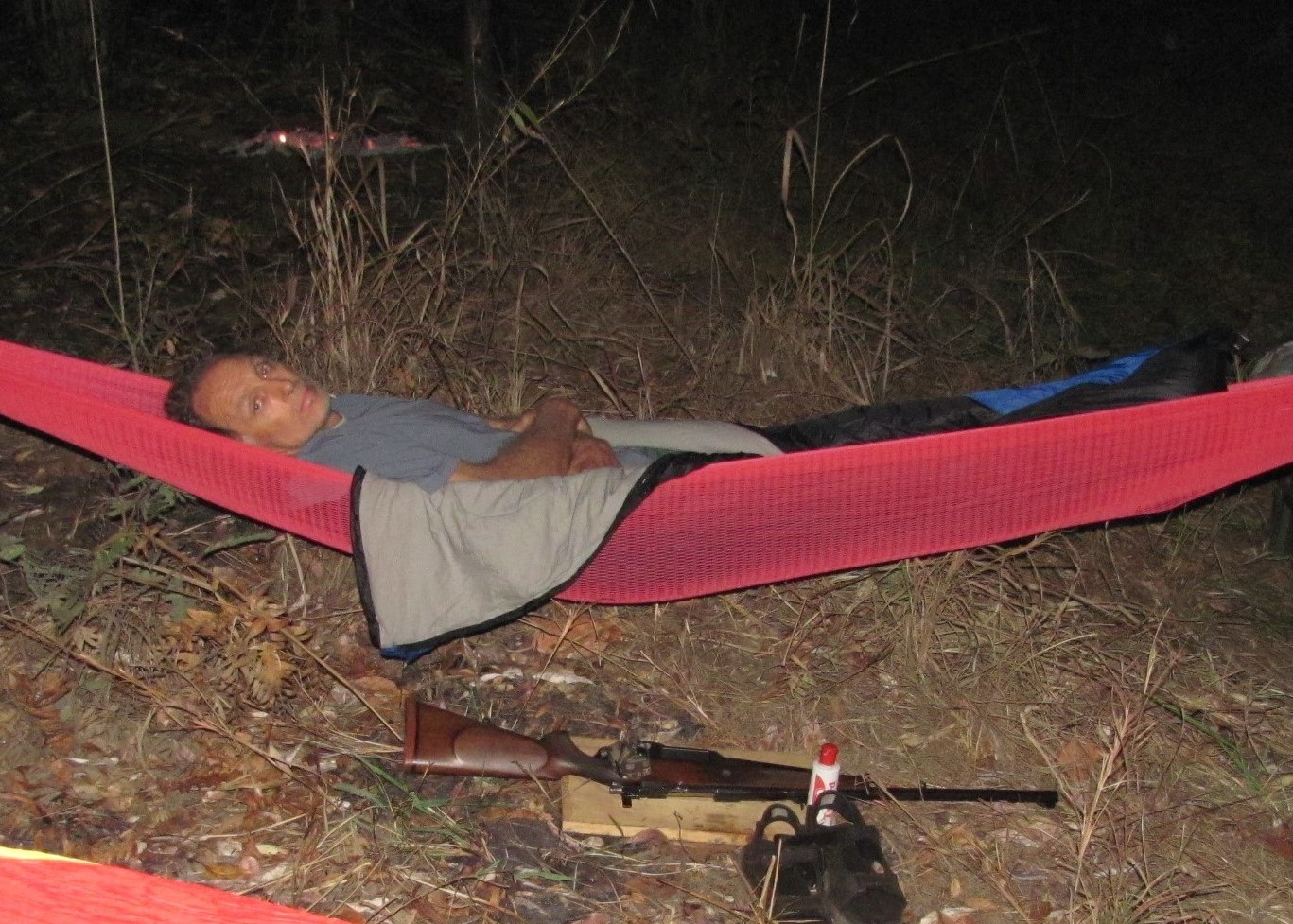You can listen to the vopice recording below, or read throught the text.
Enjoy!
Hoping for a restful night, but prepared – hammock slung low so I can easily reach down for the rifle, sandals ready, bright little LED torch between my legs inside the sleeping bag, a fire through the night – the feint glow in the background towards the top left. One of us will get up from time to time to push the logs deeper into the bed of coals, so that we have the constant lick of a slow flame.
On the near side, my companions will bed down close. They are backed up against a convenient thick tangle of sickle bush – almost impenetrable, except with considerable noise.
The risk is the head and feet sides, but it is a considered one. The area is saturated with smells unfamiliar to predators, there is the fire, which is intimidating and, on our down-wind side, it will mask our scent with the smell of wood smoke. Also, the area around is covered in a mat of dry leaves, like potato chips. Of the dangerous predators, probably only a leopard might be able to approach close without waking us.
But it is not always so easy. The large African predators will hunt any time when they are hungry, or will take an opportunistic chance with prey. But the threat from them is at its highest during the hours of dusk or darkness. Then is when they take advantage of their superior night senses to hunt earnestly. They are more alert, and, I have found, much bolder and more aggressive; I have often remarked, the same lion that will run away if they spot you during daylight, will become aggressive and predatory when it gets dark.
When we pick up signs of the presence of dangerous predators in the course of the afternoon, we take additional precautions that night. This may include taking turns to be awake, making additional fires (but it takes a lot of wood to keep them alive through the night), rigging up my little fish alarm system, sleeping upright, sitting against the trunk of a big tree, with a fire in front, crawling deep into a bush tangle where it is hard for predators to get in without noise…
However, in untouched stretches of wilderness I am usually more relaxed, even when I expect dangerous predators to be around. Animals have a natural aversion, caution, towards the human species and will avoid them, given the choice.
It is where predators – mainly lion and hyena – have grown used to the presence of unwitting humans, their odours, their sounds, their movements, that they first become inquisitive, usually drawn by the smell of leftover food, then bolder, to steal easy food, then, in a split second of arcane instinctive reaction, cross the line…
So, if I happen to end up in a stretch of “wilderness” where tourists go, I am nervous. This would typically happen when I am on my way in deep, and still with the vehicle. Then I would back the vehicle up against a tree and sling my hammock between a sturdy branch and the roll bar, so that it hangs over the centre of the load bin. If I am even more paranoid, I’d stretch a tarpaulin overhead and let it hang down over the sides of the load bin. Not hundred percent, but it will give me time to re-act.
Like in the time of the bards working the little settlements and shepherd’s camps in the hinterlands of ancient Greece, many horror stories about predator (and other) attacks are floating around bush camp fires. Some are true, some are half true, some are probably just veldt legends. They all mean the same thing. The bush is a dangerous place. You need to be alert, super alert, and you need to be careful, especially if you are alone.


Soo happy we could share it Salome.
It reminds me of the time you woke me up in the middle of the night while camping out in Botswana, saying: “Listen! Do you hear that? It’s a leopard. Probably not far from here! Isn’t it a beautiful?” …. Right there and then, destroying any remaining hope I had of getting some shut eye that night!! Lol!!
But I will always remember it as a very special moment! :)